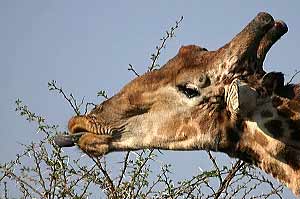Contact Details: Scotch Macaskill, Dirt Road Traders, Currys Post Road, Howick, KwaZulu-Natal, South Africa. Tel: +27 (0)82 578 2329. Privacy: Your privacy is guaranteed. See our Privacy Policy for more. This site accepts advertising and other forms of compensation - see Disclosure and Advertising for details. Site updated: 2022. Copyright © 2002 - 2022 Scotch Macaskill

| ||||||||||
|
||||||||||
|
See also info about: |
Giraffe Information
Appearance Males are larger and darker than females, have thicker horns and have a lump on the forehead. The horn tips are bald in males and old females while hairy in younger females. Behaviour However, unlike many of Africa's wild animals that "disappear" under shady trees during the heat of the day, giraffe continue browsing and because of their size, can be spotted throughout daylight hours. Giraffe will drink if water is available, but can survive without it. The forelegs are straddled and the knees bent in order to get the head down low enough. While drinking they are very vulnerable and will not drink if suspicious of danger. Females, calves and juveniles occur in herds of about 10 with only very loose social ties, and a flexible membership. Young males may form small bachelor groups. Mature bulls are nearly always alone, except when they join a female herd for mating. Young males spar by neck wrestling, twisting their necks together and trying to push the opponent off balance. Reproduction Giraffe reach sexual maturity in four to six years. Social bonds between mother and calf persist beyond weaning, until the birth of her next offspring. Calves suffer heavy predation; first year mortality can be over 40%. Diet Leaves are removed from thorny branches by combing them between the teeth. Twigs and branches are pulled into the mouth with the long and dextrous tongue. Sounds Above information from The Ultimate Field Guide and other African mammal field guides. NB: See also How the Giraffe Sorts the Leaves from the Thorns and The Giraffe is Truly Unique Return to Wildlife Info |
|||||||||
|
|
||||||||||
